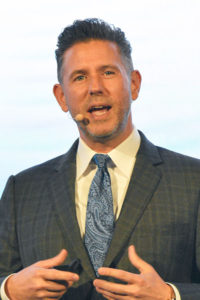
Physicians can’t stop innovation even if they wanted to, but they have a choice about how they react to the disruption of their practices and their profession, according to business futurist Patrick Schwerdtfeger during the Opening Session keynote on Monday.
They can think business as usual, make incremental innovations, and watch the technological tides sweep them aside. Or they can think big, make sweeping, even disruptive, changes and shape the future of medicine themselves.
“Technology is the leverage that drives the future,” Schwerdtfeger said. “You can be on the right side of leverage, using it to improve the care you deliver every day, or you can be on the wrong side and see your world shrink.”
Change today is driven by technology, and the key change in technology is prices that are crashing toward free. In 2000, it cost about $17,000 to store 1 terabyte of data, Schwerdtfeger noted. In 2020, 1 terabyte of storage will cost about $3.
“We live in an exponential environment,” he explained. “As costs plummet, data collection and data storage surges. By 2020, there will be 50 billion sensors connected to the internet, the Internet of Things, collecting data on almost everything we do. Each of us has to find the value in that exponential explosion of data collection and data analytics.”
Exponential change is already happening. Look no further than the Human Genome Project. Started in 1990, it took 7 years to map the first 1% of the genome.
Pundits poo-pooed the venture, predicting it would take another 700 years to finish at that rate. A few observers applauded the progress and said the end was in sight.
What the pundits missed is the growth curve in technology. Data collection and storage was scaling at 100% annually. At that rate, it would take another 6.5 years to complete the HGP.
“They were actually scaling a bit faster than anyone realized and finished in April, 2003, ahead of schedule,” Schwerdtfeger said. “And it showed the world that thinking exponentially is counterintuitive. Our brains are hardwired to think linearly, the way we experience life, but exponentially is the way we need to think. There are opportunities on the way for those who can rewire their brains and think big.”
Think virtual reality is a game? It is already being used to help surgeons visualize complex procedures and anatomies. 3D printing was a curiosity 5 years ago; today it is creating personalized medical implants. Telemedicine is a reality, so is robotic surgery, even if the surgeon and patient are thousands of miles apart.
“Machines can augment what surgeons can do with greater precision than human hands,” Schwerdtfeger said. “And machines can read x-rays more accurately than most experienced radiologists and faster than any of them.”
Just as Amazon disrupted book publishing with Kindle, and Tesla is disrupting transportation with autonomous vehicles, medicine will be disrupted, too, he predicted. That disruption will likely come from unexpected directions.
Disruptive innovation usually focuses on low-end products and markets, areas in which buyers are looking for a simpler, less expensive alternative. In health care, that definition covers almost the entire range of services and procedures. High cost and complexity are common complaints about everything from a low-level exam to the most complex surgery.
It can be difficult to predict where innovation will come from, Schwerdtfeger said. The source will most likely be unexpected. His advice is to watch for disruption from areas that are only distantly connected to health care.
“If you want to be a leader, you have to innovate and think big,” Schwerdtfeger said. “People, your staff, your peers, are inspired when you think bigger. In the end, leaders are people who are willing to think bigger. Way bigger.”





